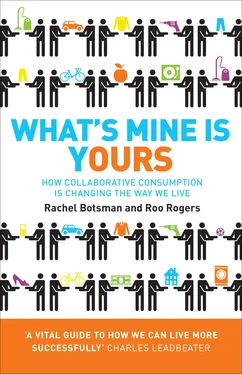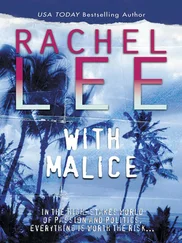Many of the companies we explore in this book are already profitable or have growing revenue models. The more established companies are making hundreds of millions in revenue (Netflix made $359.6 million and Zipcar $130 million in 2009), while others like SolarCity and Swap are just starting to turn a profit. Specific sectors of Collaborative Consumption are predicted to experience phenomenal growth over the next five years. The peer-to-peer social lending market led by the likes of Zopa and Lending Club is estimated to soar by 66 percent to reach $5 billion by the end of 2013. [10] Statistics from Gartner Research (5 January 2010). Retrieved January 2010, www.gartner.com/it/page.jsp?id=1272313.
The consumer peer-to-peer rental market for everything from drills to cameras is estimated to be a $26 billion market sector. The swap market just for used children’s clothing (0 to 13 years) is estimated to be between $1 billion and $3 billion in the United States alone. [11] Value of the market sector of used children’s clothing provided by James Reinhart, founder of thredUP.
Car sharing or per hour car rental is predicted to become a $12.5 billion industry. Even organizations such as CouchSurfing and Freecycle that were set up for a purpose not explicitly about profitability are helping create consumer acceptance and paving the way for similar businesses with a revenue model. CouchSurfing, a nonprofit organization, created the space for the likes of Airbnb and CrashPadder. And it’s not just the companies making money. As The Economist noted, individuals involved in Collaborative Consumption are becoming ‘microentrepreneurs.’ [12] L.S., ‘Collaborative Consumption’, posted on the Economist blog (22 April 2010), http://www5.economist.com/blogs/babbage/2010/04/peer_to_peer_car_rentals.
Some people are making a little money on the side and others are making significant income from peer rental of products and spaces that would otherwise be sitting unused and idle. The average New Yorker participating in Airbnb is making $1,600 per month. And that is just the average. Renters on Zilok are making over $1,000 a year from renting out just one item such as a camera or bike. It is estimated that an owner of a saloon car such as a Camry can make over $6,250 per year through peer-to-peer car rental sites such as RelayRides, Gettaround and Whipcar by renting the car for twenty hours a week. Some owners, such as ‘Dave,’ a twenty-six-year-old designer, are using Whipcar to help pay for general living costs. Others, such as sixty-six-year-old ‘Maureen’, hardly use their car and use the extra rental money to pay for holidays.
People may throw an ‘out of necessity’ brick at Collaborative Consumption, claiming that it will slow down or crumble when the economy fully recovers and prosperity returns. But not only is Collaborative Consumption driven by consumer motivations that extend far deeper than cost savings, the habits started to stick and spread before the financial collapse of 2008. Economic necessity has just made people more open to new ways of accessing what they need and how to go about getting it.
When the great recession hit in 2008, some pundits and economists heralded the end of consumerism, while some suggested that consumers needed to be prodded to shop again. Either way, they assumed that the traditional model of consumerism, the one in which we buy products, use them, throw them away and then buy more, would continue, even if at a hobbled rate. While the ‘spend more, consume more’ way out may be a short-term fix, it is neither sustainable nor healthy.
While the rampant and unregulated financial system led to investors losing millions in Ponzi schemes, hedge funds, insurance companies and even savings banks, everyday people pursuing the supposed American dream felt the worst impact. In all corners of the world, millions lost their homes, their jobs, their buying power and their confidence. But within weeks of the crash, there were signs of a new and increasing consumer awareness, tinged with anger. We have been living in a society that for more than fifty years has encouraged us to live beyond our means, both financial and ecological. As Thomas Friedman wrote in a New York Times op-ed, ‘2008 was when we hit the wall – when Mother Nature and the market both said: “No more.”’ While the world awaits a new big idea to reinvigorate and rebalance our economy, we believe the transformation will start to come from consumers themselves.
The convergence of social networks, a renewed belief in the importance of community, pressing environmental concerns and cost consciousness are moving us away from top-heavy, centralized and controlled forms of consumerism towards one of sharing, aggregation, openness and cooperation.
To build on an idea Charles Leadbeater discussed in his book We Think , in the twentieth century of hyper-consumption we were defined by credit, advertising and what we owned; in the twenty-first century of Collaborative Consumption we will be defined by reputation, by community, and by what we can access and how we share and what we give away. [13] Charles Leadbeater, We-Think: Mass Innovation Not Mass Production (Profile Books, 2008), 26.
The phenomenon of sharing via increasingly ubiquitous cyber peer-to-peer communities such as Linux, Wikipedia, Flickr, Digg and YouTube is by now a familiar story. Collaborative Consumption is rooted in the technologies and behaviours of online social networks. These digital interactions have helped us experience the concept that cooperation does not need to come at the expense of our individualism, opening us up to innate behaviours that make it fun and second nature to share. Indeed, we believe people will look back and recognize that Collaborative Consumption started online – by posting comments and sharing files, code, photos, videos and knowledge. And now we have reached a powerful inflection point, where we are starting to apply the same collaborative principles and sharing behaviours to other physical areas of our everyday lives. From morning commutes to co-working spaces to the way we borrow and lend money to the way fashion is designed, different areas of our lives are being created and consumed in collaborative ways.
This book does not posit that we need to pick between owning or sharing. In the future, most of us will have our feet in both camps, just as successful business models such as Airbnb may become a hybrid of both traditional commerce and collaboration. Collaborative Consumption will sit side-by-side and eventually may go head-to-head with the old consumerist model, much as blogs such as the Huffington Post now compete with hundred-plus-year-old newspapers such as The New York Times . But in the same way that the one-way flow of information from the media is over, we are reaching the close of a pure one-way consumerist culture based on just owning more and more stuff. ‘Sharing is to ownership what the iPod is to the eight track, what the solar panel is to the coal mine. Sharing is clean, crisp, urbane, postmodern; owning is dull, selfish, timid, backward,’ New York Times journalist Mark Levine commented recently. [14] Mark Levine, ‘Share My Ride’, The New York Times (5 March 2009), http://www.nytimes.com/2009/03/08/magazine/08Zipcar-t.html.
Concepts and connotations of ‘sharing’, ‘collectivism’ and ‘communalism’ need to be updated. In his classic novel Through the Looking-Glass , Lewis Carroll writes, ‘“When I use a word,” Humpty Dumpty said, in rather a scornful tone, “it means just what I choose it to mean – neither more nor less.” “The question is,” said Alice, “whether you can make words mean so many different things.” “The question is,” said Humpty Dumpty, “which is to be master – that’s all”.’ [15] Lewis Carroll, Through the Looking-Glass (Macmillan, 1871), 205.
Meanings of words can change as our cultural acceptance of ideas is reframed. [16] This idea was raised in the blog post ‘Socialism or Not: Lessig Responds to Kelly’, Adrian J. Ivakhiv (31 May 2009), http://aivakhiv. blog.uvm.edu/2009/05/socialism_or_not_lessig_responds_to_kelly. html.
Hotels don’t call their business ‘bed sharing’ for good reasons, and as Jonathan Zittrain, a professor of law at Harvard University, says, craigslist does not call its ride-sharing board ‘hitchhiking.’
Читать дальше












